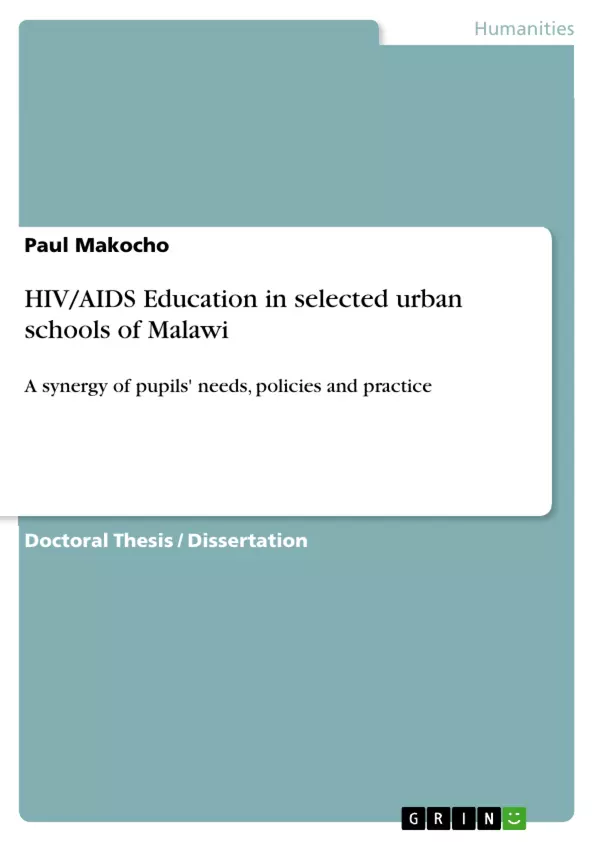The needs of young people in classroom based HIV/AIDS Education in Malawi, the extent to which current classroom practices respond to these needs, and the factors influencing these responses have been explored using questionnaires, interviews, lesson observations, and document analysis.
In contrast to previously reported literature on HIV/AIDS Education in Malawi, the present study has drawn pupils’ needs directly from the pupils’ themselves, focussed on classroom practice, and triangulated the various data sets to give a comprehensive picture of HIV/AIDS Education in Malawi.
Pupils identified a need for open discussion climates on HIV/AIDS issues despite a conservative cultural and religious adult world that is not open. They also identified a need for explicit and accurate knowledge on HIV/AIDS issues, opportunities to acquire behavioural skills for HIV prevention, and involvement of external speakers.
The needs of the pupils have not been adequately addressed by the current classroom practice. Factors which influenced this can be linked to lack of policies that are responsive to culture and religion, ineffective and inadequate teaching policy guidelines, and lack of a policy prioritizing HIV/AIDS education by making it examinable.
The findings suggest that in future, effective HIV/AIDS Education needs to be informed by the pupils’ needs. To address these needs, support from the wider society and related policies, coupled with appropriate management and classroom practice will be required. Understanding these lessons is a must for HIV/AIDS curriculum developers, policy makers and implementers in any education system.
Table of Contents
- Introduction
- Literature Review
- Conceptual Framework
- Theoretical Framework
- HIV/AIDS Education in Malawi
- Policy and Legal Framework
- HIV/AIDS Education Programmes in Malawi
- Factors Influencing HIV/AIDS Education in Malawi
- Pupils' Needs in HIV/AIDS Education
- Research Methodology
- Research Design
- Data Collection Methods
- Data Analysis
- Findings and Discussions
- Pupils' Needs
- Factors Influencing Classroom Practices
- Effectiveness of HIV/AIDS Education
- Conclusion
- Recommendations
Objectives and Key Themes
This PhD thesis investigates the needs of young people in classroom-based HIV/AIDS education in Malawi, particularly in Zomba Urban Secondary Schools. It examines the extent to which current practices respond to these needs and the factors influencing such responses. The study employed a mixed-methods approach, utilizing questionnaires, interviews, lesson observations, and document analysis.
- Pupils' Needs in HIV/AIDS Education
- Effectiveness of Current Classroom Practices
- Factors Influencing Classroom Practices
- Policy and Legal Framework in Malawi
- Triangulation of Data Sets for a Comprehensive Picture of HIV/AIDS Education
Chapter Summaries
The introduction outlines the context and rationale behind the study, highlighting the significance of HIV/AIDS education in Malawi. The literature review delves into the conceptual and theoretical frameworks underpinning the research, exploring existing scholarship on HIV/AIDS education in Malawi, including its policy and legal framework, prevalent programs, and influential factors.
The research methodology chapter details the chosen design, data collection methods, and analysis techniques employed. The findings and discussions section presents the key results, analyzing pupils' needs, the effectiveness of current classroom practices, and the factors influencing these practices.
Keywords
This thesis focuses on the key areas of HIV/AIDS education, classroom practices, pupil needs, and factors influencing education effectiveness in Malawi. It highlights the crucial role of policy, cultural and religious context, and triangulation of data in understanding the complexities of this issue. The study further contributes to the ongoing dialogue surrounding the implementation and impact of HIV/AIDS education initiatives in developing countries, particularly within the context of a conservative cultural and religious environment.
- Quote paper
- Paul Makocho (Author), 2012, HIV/AIDS Education in selected urban schools of Malawi, Munich, GRIN Verlag, https://www.grin.com/document/265279



